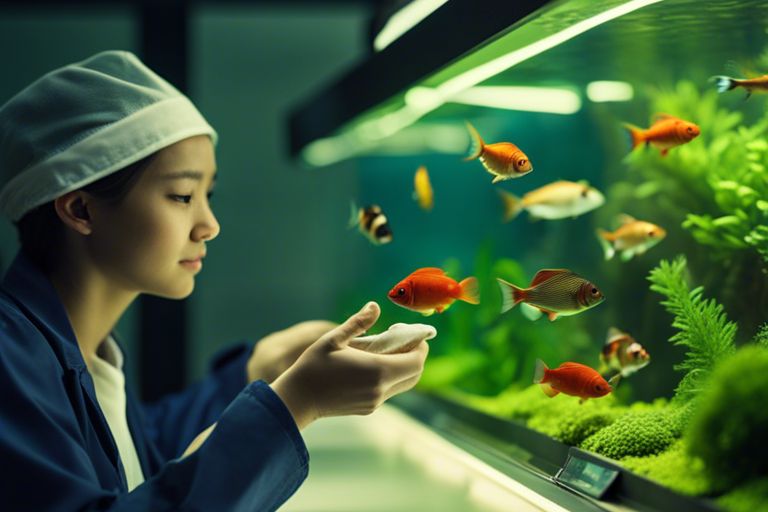The world of fishkeeping can be a rewarding experience, but it also comes with its own set of challenges. The health of your fish is of utmost importance, and one of the key aspects of fishkeeping is understanding and preventing common fish diseases. In this informative guide, we’ll discuss some of the most prevalent fish diseases, their causes, symptoms, and most importantly, how to effectively treat and prevent them to ensure the well-being of your aquatic companions.

Bacterial Infections in Fish
Identifying Bacterial Infections
For fish owners, identifying bacterial infections in their aquatic pets is crucial to ensuring timely treatment and preventing the spread to other tank inhabitants. The common signs of bacterial infections in fish include lethargy, loss of appetite, abnormal swimming patterns, discoloration, and the presence of sores or ulcers on the fish’s body.
Preventive Measures
The best way to combat bacterial infections in fish is through preventive measures. Maintaining good water quality, providing a balanced diet, avoiding overcrowding in the tank, and quarantining new fish before introducing them to the main tank are vital steps to reduce the risk of bacterial infections.
Bacterial infections in fish are often opportunistic, taking hold when the fish’s immune system is compromised due to stress, poor water quality, or inadequate nutrition. By addressing these underlying issues, fish owners can significantly lower the chances of bacterial outbreaks in their aquarium.
Treatment Options
The key to successfully treating bacterial infections in fish is early detection and prompt action. There are several treatment options available, including medicated fish food, antibiotics, and antimicrobial treatments that can be added to the water. It is vital to follow the dosing instructions carefully and complete the full treatment course to ensure the eradication of the bacterial infection.
Another important aspect of treating bacterial infections in fish is to isolate the infected fish in a separate quarantine tank to prevent the spread of the infection to other tank mates. Regular monitoring of water parameters and the fish’s condition is also critical to evaluate the effectiveness of the treatment and make any necessary adjustments.

Parasitic Diseases in Aquatic Life
Recognition and Diagnosis of Parasitic Infestations
Any fish hobbyist should be aware of the signs of parasitic infestations in aquatic life. Symptoms such as abnormal swimming behavior, visible parasites on the fish, changes in appetite, and skin lesions are common indicators of a parasitic infection.
Prevention Strategies for Parasitic Diseases
Life in an aquarium can be susceptible to parasitic diseases if proper preventive measures are not taken. It is crucial to maintain good water quality, avoid overcrowding, quarantine new fish before adding them to the tank, and regularly clean and disinfect equipment to minimize the risk of parasite introduction.
It is also recommended to feed your fish a balanced diet to boost their immune systems and make them less vulnerable to parasitic infections. Additionally, performing regular water changes and monitoring the overall health of your fish can help detect any potential issues early on.
Effective Treatments for Eradicating Parasites
Aquatic parasites can be challenging to eradicate once they have infested your fish. However, there are effective treatments available in the form of medicated food, baths, and dips that can help eliminate parasites from your aquarium. Consult with a veterinarian or an experienced fish keeper to determine the best treatment plan for your specific situation.
Understanding the life cycle of common parasites and their preferred hosts can also help in developing targeted treatment strategies. Be diligent in following treatment protocols and closely monitor your fish during and after treatment to ensure a successful eradication of parasites.
Fungal Infections of Fish
Symptoms and Signs of Fungal Infections
Now, fungal infections are common in fish and can be identified by the presence of white cotton-like growth on the skin, fins, or gills. Additionally, affected areas may appear inflamed, and fish may show signs of lethargy and loss of appetite.
Implementing Prevention Techniques
Infections can be prevented by maintaining good water quality, proper diet, and avoiding overcrowding in the tank. It is crucial to quarantine new fish before introducing them to the main tank to prevent the spread of fungal infections.
It is also vital to regularly clean and maintain the tank, perform routine water changes, and ensure adequate filtration to minimize the risk of fungal infections.
Treatment Modalities for Fungal Issues
One of the most effective treatments for fungal infections is the use of antifungal medications specifically designed for fish. These medications can be added to the water or applied topically, following the manufacturer’s instructions carefully.
For instance, increasing the water temperature slightly can help speed up the recovery process for the fish, as many fungal infections thrive in cooler water temperatures.
Viral Diseases Affecting Fish
Common Viral Diseases in Aquaria and Ponds
Many viral diseases can affect fish kept in aquaria and ponds. Some common viral infections include viral hemorrhagic septicemia (VHS), infectious hematopoietic necrosis (IHN), and viral nervous necrosis (VNN). These viruses can spread quickly and devastate fish populations if not properly managed.
Precautions to Avoid Viral Outbreaks
Fish enthusiasts must take precautions to avoid viral outbreaks in their aquatic environments. Quarantining new fish before introducing them, maintaining good water quality, and avoiding overstocking can help prevent the spread of viruses. Regular cleaning and disinfection of equipment and ensuring proper nutrition for fish can also boost their immune systems to resist viral infections.
Regular monitoring of fish behavior and appearance is crucial in detecting early signs of viral diseases. If any fish show symptoms such as abnormal swimming patterns, lesions, or unusual coloration, immediate isolation and treatment are necessary to prevent further spread of the virus to other aquatic inhabitants.
Approaches to Managing Viral Infections
Another important aspect in combating viral infections in fish is to implement proper management approaches. This includes using vaccines where available, maintaining optimal water conditions, and implementing biosecurity measures. Isolation of infected fish and prompt removal of dead fish can also help in controlling the spread of viruses within the aquatic environment.
Affecting both aquaria and ponds, viral diseases can be challenging to manage, but with proper precautions and swift action, fish enthusiasts can minimize the impact of these infections and protect their aquatic companions.

Water Quality and Fish Health
Maintaining Optimal Water Conditions
Quality water is important for the health of your fish. Maintaining optimal water conditions involves monitoring parameters such as temperature, pH, ammonia, nitrites, and nitrates. Regular water testing and proper filtration are key to ensuring a healthy aquatic environment for your fish.
The Relation Between Water Quality and Disease Prevention
Maintaining good water quality is fundamental in preventing fish diseases. Poor water conditions can weaken the immune system of your fish, making them more susceptible to infections. By ensuring clean and well-oxygenated water, you create an environment that promotes the overall health and well-being of your aquatic pets.
Plus, water quality is closely linked to stress levels in fish. Stress from poor water conditions can lead to diseases such as fin rot, ich, and bacterial infections. By keeping water quality in check, you not only prevent diseases but also promote a thriving ecosystem within your aquarium.
Summing up
Considering all points discussed, it is evident that prevention plays a crucial role in avoiding common fish diseases. Maintaining good water quality, proper feeding, and quarantine procedures are key factors in preventing outbreaks. However, in case of an infection, swift action through proper diagnosis and treatment is imperative. Regular monitoring of fish behavior and appearance can help in early detection and effective treatment. By following these guidelines, fish enthusiasts can create a healthy environment for their aquatic companions and ensure their well-being.
FAQ
Q: What are some common fish diseases?
A: Common fish diseases include Ich, fin rot, velvet disease, and dropsy.
Q: How can fish diseases be prevented?
A: Fish diseases can be prevented by maintaining good water quality, avoiding overstocking the tank, and quarantining new fish before introducing them to an existing tank.
Q: What are the symptoms of fish diseases?
A: Symptoms of fish diseases can include frayed fins, white spots on the body, bloating, and lethargy.
Q: How should sick fish be treated?
A: Sick fish should be quarantined immediately to prevent the spread of disease, and appropriate medication should be administered as directed.
Q: Can fish diseases be contagious?
A: Yes, fish diseases can be contagious and may spread quickly if not addressed promptly.
Q: How often should fish tanks be cleaned to prevent diseases?
A: Fish tanks should be cleaned regularly, with partial water changes performed weekly and thorough cleanings as needed to maintain optimal water quality.
Q: Are there any natural remedies for treating fish diseases?
A: Some natural remedies for treating fish diseases include aquarium salt baths, garlic supplements, and herbal treatments, but it is important to consult with a vet or experienced aquarist before trying these methods.











